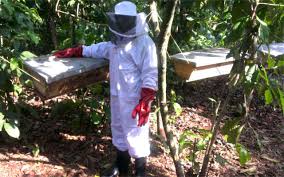

Traditional methods of bee keeping are still predominant in Uganda where it remains an important seasonal activity in many regions. Rural people have a good knowledge of bees, plants and places favoured by bees but hives are usually destroyed and colonies often killed in the process of collecting honey. Contamination and fermentation of honey is also common. Despite the diversity of vegetation suitable for bees in the region, a shortage of bees means that beekeepers are dependent on collecting swarming bee stock. The current shortage is also limiting production of honey and by-products for which there is considerable potential.
Beehives are traditionally constructed from timber, bamboo boruss palms or woven from forest climbers and honey is usually harvested twice a year between March – June and the secondary season in August – October. The most favoured bees are Apis mellifera adansonii but six species of stingless Trigonid bees are also used in Ugandan honey production. However, hives are crudely raided at night with the use of grass torches and fire to smoke out the bees leaving many colonies destroyed. Honey is eaten directly from combs or is extracted and the surplus is sold or given to neighbours or relatives. Other bee products (brood comb and bee bread) are also harvested but, although they may be used, they are often wasted.
A few keepers have modern honey presses but, more commonly, honeycombs are pressed by hand. Much of the honey produced has impurities, including wax and bee parts. Those who have invested in pressing machines produce better quality honey. Honey from honeycomb is extracted, warmed, strained and bottled. Some is sold to clinics to be used for medicinal applications, including treatment of sorethroats, and by HIV/AIDS sufferers who take it to treat opportunistic infections. Propolis is also in high demand by the medical sector for treatment of diseases. Some beekeepers salvage the comb to use its wax for candles or, mixed with maize flour, to make ice-cream cones. In addition, wax is in demand by cobblers, makers of household textiles, and garments and for making batiks.
The Ugandan Beekeepers Association estimates that only between 800-1200 metric tonnes of honey is produced per year due to current lack of beestock. The Association has introduced improved wooden hives costing about US$15 (Uganda shillings 25,000), which can be opened for checking honeycombs and reduces the damage inflicted to a colony. The Association also has smoker pumps and protective wear to sell to keepers but unfortunately most beekeepers are unable to afford these items.
Eria Nsubuga Nvule, a bee expert in Uganda and a lecturer in the department of Zoology at Makerere University has said that absence of queen bee raising and bee-packaging projects are the main constraints to the modernization of beekeeping in the region. Mr Nvule, who is also an expert in artificial insemination in bees, said queen bee raising and packaging would be a step to improved beekeeping, honey and wax production and improvement of incomes and the environment, since honey has a ready local market and bees can be used to improve pollination. He also believes there should be a deliberate effort by the government and development agencies to revise policies in order to prohibit indiscriminate bush burning and tree felling.
The Queen Bee and Bee Packaging project would be an impetus to modernizing bee keeping as it would enable multiplication of the native bee stock and promote a variety of different strains according to beekeeper’s needs (e.g. an industrious strain to forage nectar, a strain that does not swarm, and a gentle strain that can be handled by any lay person). A German NGO, Action Africa Hilfe (AAH) in collaboration with Mr. Nsubuga Nvule, has recently introduced such a project in Palorinya Sudanese Refugee Camp in Moyo along the Uganda-Sudan border. The project supplied many hives and starter colonies to help refugees begin beekeeping in order to improve their incomes.
 Contact Jaguza Support
Contact Jaguza Support